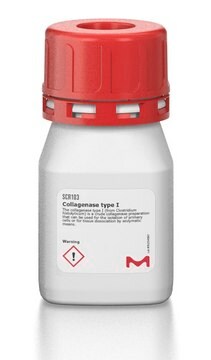D4292
3,3′-Dioctadecyloxacarbocyanine perchlorate
≥98% purity (TLC), powder
Synonyme(s) :
DiOC18(3), ‘DiO’
About This Item
Produits recommandés
product name
3,3′-Dioctadecyloxacarbocyanine perchlorate,
Pureté
≥98% (TLC)
Niveau de qualité
Forme
powder
Couleur
orange
Solubilité
chloroform: 50 mg/mL
Fluorescence
λex 484 nm; λem 501 nm in methanol
Application(s)
diagnostic assay manufacturing
hematology
histology
Température de stockage
2-8°C
Chaîne SMILES
[O-]Cl(=O)(=O)=O.CCCCCCCCCCCCCCCCCCN1C(\Oc2ccccc12)=C/C=C/c3oc4ccccc4[n+]3CCCCCCCCCCCCCCCCCC
InChI
1S/C53H85N2O2.ClHO4/c1-3-5-7-9-11-13-15-17-19-21-23-25-27-29-31-37-46-54-48-40-33-35-42-50(48)56-52(54)44-39-45-53-55(49-41-34-36-43-51(49)57-53)47-38-32-30-28-26-24-22-20-18-16-14-12-10-8-6-4-2;2-1(3,4)5/h33-36,39-45H,3-32,37-38,46-47H2,1-2H3;(H,2,3,4,5)/q+1;/p-1
Clé InChI
GFZPJHFJZGRWMQ-UHFFFAOYSA-M
Vous recherchez des produits similaires ? Visite Guide de comparaison des produits
Application
Actions biochimiques/physiologiques
Mention d'avertissement
Warning
Mentions de danger
Conseils de prudence
Classification des risques
Eye Irrit. 2 - Skin Irrit. 2 - STOT SE 3
Organes cibles
Respiratory system
Code de la classe de stockage
11 - Combustible Solids
Classe de danger pour l'eau (WGK)
WGK 3
Point d'éclair (°F)
Not applicable
Point d'éclair (°C)
Not applicable
Équipement de protection individuelle
dust mask type N95 (US), Eyeshields, Gloves
Certificats d'analyse (COA)
Recherchez un Certificats d'analyse (COA) en saisissant le numéro de lot du produit. Les numéros de lot figurent sur l'étiquette du produit après les mots "Lot" ou "Batch".
Déjà en possession de ce produit ?
Retrouvez la documentation relative aux produits que vous avez récemment achetés dans la Bibliothèque de documents.
Les clients ont également consulté
Articles
Nitric oxide (NO) as a signal transporter in neurons, endothelial cells and in the immune system.
Notre équipe de scientifiques dispose d'une expérience dans tous les secteurs de la recherche, notamment en sciences de la vie, science des matériaux, synthèse chimique, chromatographie, analyse et dans de nombreux autres domaines..
Contacter notre Service technique










